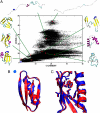Principles and Overview of Sampling Methods for Modeling Macromolecular Structure and Dynamics
- PMID: 27124275
- PMCID: PMC4849799
- DOI: 10.1371/journal.pcbi.1004619
Principles and Overview of Sampling Methods for Modeling Macromolecular Structure and Dynamics
Abstract
Investigation of macromolecular structure and dynamics is fundamental to understanding how macromolecules carry out their functions in the cell. Significant advances have been made toward this end in silico, with a growing number of computational methods proposed yearly to study and simulate various aspects of macromolecular structure and dynamics. This review aims to provide an overview of recent advances, focusing primarily on methods proposed for exploring the structure space of macromolecules in isolation and in assemblies for the purpose of characterizing equilibrium structure and dynamics. In addition to surveying recent applications that showcase current capabilities of computational methods, this review highlights state-of-the-art algorithmic techniques proposed to overcome challenges posed in silico by the disparate spatial and time scales accessed by dynamic macromolecules. This review is not meant to be exhaustive, as such an endeavor is impossible, but rather aims to balance breadth and depth of strategies for modeling macromolecular structure and dynamics for a broad audience of novices and experts.
Conflict of interest statement
The authors have declared that no competing interests exist.
Figures




Similar articles
-
Macromolecular crowding: chemistry and physics meet biology (Ascona, Switzerland, 10-14 June 2012).Phys Biol. 2013 Aug;10(4):040301. doi: 10.1088/1478-3975/10/4/040301. Epub 2013 Aug 2. Phys Biol. 2013. PMID: 23912807
-
Computational approaches to macromolecular interactions in the cell.Curr Opin Struct Biol. 2019 Apr;55:59-65. doi: 10.1016/j.sbi.2019.03.012. Epub 2019 Apr 15. Curr Opin Struct Biol. 2019. PMID: 30999240 Free PMC article. Review.
-
Chemical exchange in biomacromolecules: past, present, and future.J Magn Reson. 2014 Apr;241:3-17. doi: 10.1016/j.jmr.2014.01.008. J Magn Reson. 2014. PMID: 24656076 Free PMC article. Review.
-
Advances in coarse-grained modeling of macromolecular complexes.Curr Opin Struct Biol. 2018 Oct;52:119-126. doi: 10.1016/j.sbi.2018.11.005. Epub 2018 Nov 30. Curr Opin Struct Biol. 2018. PMID: 30508766 Free PMC article. Review.
-
Molecular dynamics, monte carlo simulations, and langevin dynamics: a computational review.Biomed Res Int. 2015;2015:183918. doi: 10.1155/2015/183918. Epub 2015 Feb 16. Biomed Res Int. 2015. PMID: 25785262 Free PMC article. Review.
Cited by
-
Structural analysis of ACE2 variant N720D demonstrates a higher binding affinity to TMPRSS2.Life Sci. 2020 Oct 15;259:118219. doi: 10.1016/j.lfs.2020.118219. Epub 2020 Aug 5. Life Sci. 2020. PMID: 32768580 Free PMC article.
-
Enzyme dynamics: Looking beyond a single structure.ChemCatChem. 2020 Oct 6;12(19):4704-4720. doi: 10.1002/cctc.202000665. Epub 2020 Jun 26. ChemCatChem. 2020. PMID: 33897908 Free PMC article.
-
Phenoxyethyl Piperidine/Morpholine Derivatives as PAS and CAS Inhibitors of Cholinesterases: Insights for Future Drug Design.Sci Rep. 2019 Dec 27;9(1):19855. doi: 10.1038/s41598-019-56463-2. Sci Rep. 2019. PMID: 31882733 Free PMC article.
-
The stability and self-assembly of tri-calcium silicate and hydroxyapatite scaffolds in bone tissue engineering applications.J Biol Eng. 2025 Feb 17;19(1):16. doi: 10.1186/s13036-025-00481-4. J Biol Eng. 2025. PMID: 39962588 Free PMC article.
-
Balancing multiple objectives in conformation sampling to control decoy diversity in template-free protein structure prediction.BMC Bioinformatics. 2019 Apr 25;20(1):211. doi: 10.1186/s12859-019-2794-5. BMC Bioinformatics. 2019. PMID: 31023237 Free PMC article.
References
-
- Soto C. Protein misfolding and neurodegeneration. JAMA Neurology. 2008;65(2):184–189. - PubMed
-
- Uversky VN. Intrinsic disorder in proteins associated with neurodegenerative diseases. Front Biosci. 2009;14:5188–5238. - PubMed
-
- Onuchic JN, Luthey-Schulten Z, Wolynes PG. Theory of protein folding: the energy landscape perspective. Annu Rev Phys Chem. 1997;48:545–600. - PubMed
Publication types
MeSH terms
Substances
Grants and funding
LinkOut - more resources
Full Text Sources
Other Literature Sources

